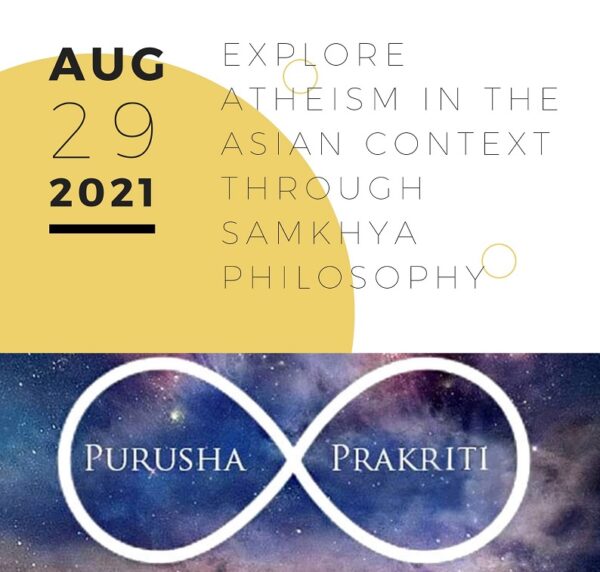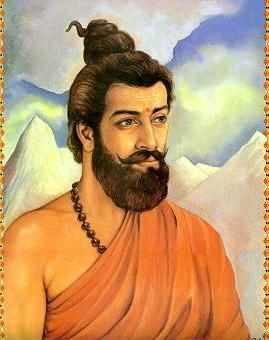
Atheism is typically seen as a modern phenomenon. Tim Whitmarsh, Professor of Greek and a fellow of St. John’s College, University of Cambridge thinks otherwise. In his book Battling the Gods, he suggested that it exists in more societies, has a wealth of tradition of its own, and, indeed, its own heroes.
Thus, on 29 August 2021, the Humanist Society (Singapore) organised a sharing session on Zoom about the fascinating Indian philosophical school of Samkhya. This talk was hosted by N. Madasamy (‘Nora’), current Secretary of the Society.
Samkhya’s historical development
Nora started by introducing Samkhya as one of the six major schools of Hindu philosophy, the others being Yoga, Nyaya, Vaisheshika, Mimamsa and Vedanta.
She then explained what the word means – Samkhya combines “Sam” (Balance) and “khya” (Knowledge, declaration). Combined, it means balanced knowledge based on philosophical reflection. Samkhya, a Sanskrit word, can also mean “to reckon, count, enumerate, calculate, deliberate, reason, reasoning by numeric enumeration, relation to numbers”. Philosophically, Samkhya refers to the philosophical school in Hinduism based on systemic enumeration and rational examination.

Nora then introduced the founder of this philosophy, Kapila (above), the competing interpretations of Samkhya philosophy, as well as the philosophy’s historical development.
Samkhya’s historical development went through 4 periods: Ancient Speculation, Proto Samkhya, Classical Samkhya, Later Samkhya.
Samkhya began to held in great esteem from the Proto-Samkhya period. Over time, it developed an atheistic side in the Classical Samkhya era. In fact, two important components of the philosophy first appeared at the classical period – atheism and transcendental plurality of souls.
Samkhya was most vigorous during the early centuries of the classical period, but had begun to decline after around the eighth century A.D. In the Later Samkhya period, the theistic element (present in pre-Classical Samkhya) was reintroduced back to Samkhya.

(Above) The famous Jain Dilwara Temples in Rajasthan. Both Jainism and Samkhya philosophy is influenced by the Sramana movement, “renouncer tradition” that arose in India between 800 and 400 BCE.
Main ideas of Samkhya
Nora explained the main tenets of Samkhya:
- Theory of causation (satkaryavada): According to this theory of cause and effect, the effect is already pre-existent in the cause. For example, milk being the cause, its effect yogurt pre-exists in the milk. Based on a certain specific trigger, the effect gets manifested from the cause.
- Concept of duality, two independent entities: this universe of animate and inanimate object is the creation of two distinct, independent entities called Purusha and Prakriti. Both these entities are eternal and real. Purusha is pure consciousness whereas Prakriti is the primordial material entity, which has no consciousness of its own. The universe gets manifested from the unmanifest Prakriti through the proximity and conjunction between Purusha and Prakriti.
- The theory of evolution of the material universe (25 elements, called “tattwas”) — one of its most fascinating contributions. As stated above, evolution began when the perfect balance of the three gunas in the Mula Prakriti was disturbed, resulting in the elements (tattwas).
- The concept of liberation (moksha, kaivalya) – Samkhya recognizes that we are always dealing with three types of suffering. Even what may seem pleasurable for the time being will ultimately result in disappointment and suffering. The reason for this suffering is our ignorance – we are not aware of our true nature. We are constantly identifying ourselves with the mind-body complex which results in the perpetual cycle of birth, death and re-birth.
- Theory of knowledge (pramana) – Three sources of valid knowledge – direct perception (drishtam), inference (anumana) and valid testimony (apta-vachana). Sutra SK-4 states, “Perception, inference, and valid testimony are the sources for establishing all correct knowledge.”
- Concept of the three gunas – sattva, rajas and tamas – Everything in this material universe is a composite of three gunas – sattva (purity), rajas (action) and tamas (dullness). The unmanifest Prakriti is nothing but the combination of these three gunas present in a state of perfect balance or equilibrium.
More info about Samkhya philosophy can be found here – https://en.wikipedia.org/wiki/Samkhya
Samkhya has some interesting arguments regarding the existence of a creator
- No Supreme Being, or creator of the universe. The fact of the material world is taken as a given – no creator needed. As a form of spirituality, it recognizes the possibility of transcendence.
- The word creation implies the existence of two ultimate realities – the creator and some other entity comprising of raw material with which the creator creates. This also means the creator is depended upon another and not the only ultimate reality of the universe.

(Above) Nora giving the talk on 29 Aug, on Zoom, due to Covid-19 safety arrangements.
Decline of Samkhya
By the end of the 10th or 11th century, Samkhya lost its independent status and identity. By the 16th century, Samkhya had got assimilated with the orthodox systems and lost its dependence. Samkhya and Yoga were segregated, sanctified, rendered theistic and brought into Vedic fold as two separate disciplines.
Unlike Buddhism or some sects of Hinduism, the Samkhya did not develop into institutional forms. It remained a sort of secret-knowledge with discussions between close groups of ascetics, Yogis and intellectuals only. With the Samkhya School turning theistic and getting absorbed into the orthodox traditions, it lost its identity. The interest in Samkhya ideologies, even among the intellectuals, remained merely academic today.
Relevancy of Samkhya in modern context
Samkhya advocates that each of us has the potential to rise above our human condition and attain a state or condition beyond the limitations of our individuality, psychology, physical body, social conditioning, historical context, and even the space-time continuum we find ourselves in.
Samkhya as a spiritual domain is not about worship of a supreme deity, blind faith, empty ritualism, meaningless ceremony, traditionalism, fundamentalism, infallible sacred scripture, ecclesiastical authority, but is a philosophical outlook based on self-enquiry, analytical discrimination and discerning the fundamental facts concerning our human conditions.
The Humanist Society (Singapore) thanks Nora for her extensive preparations and sharing!




